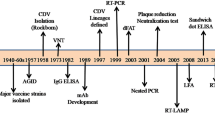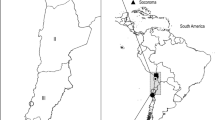Abstract
American bison (Bison bison) and domestic cattle (Bos taurus and Bos indicus) evolved from a common ancestor 1–1.4 million years ago. Nevertheless, they show dramatic differences in their susceptibility to infectious diseases, including malignant catarrhal fever (MCF). Although bison are highly susceptible to ovine herpesvirus-2 (OvHV-2) associated MCF, about 20% of healthy domesticated and wild bison are positive for OvHV-2 antibody. We are interested in testing the hypothesis that, within the bison population, the polymorphism of major histocompatibility complex (MHC) class II genes influences resistance to MCF. However, since little was known about the MHC class II genes of bison, it was necessary to first characterize class II haplotypes present in Bi. bison (Bibi). Thus, the MHC class II haplotypes carried by 14 bison were characterized by the PCR-based cloning and sequencing of their DRB3, DQA, and DQB alleles. Twelve MHC class II haplotypes were identified in the 14 bison. These haplotypes comprised six previously reported and six new Bibi-DRB3 alleles, along with 11 Bibi-DQA and 10 Bibi-DQB alleles. For each bison class II allele, it was possible to identify closely related cattle sequences. The closest bison and bovine DQA, DQB, and DRB3 alleles, on average, differed by only 1.3, 3.5, and 5.8 amino acids, respectively. Furthermore, bison MHC haplotypes with both nonduplicated and duplicated DQ genes were identified; these haplotypes appear to have originated from the same ancestral haplotypes as orthologous cattle haplotypes.




Similar content being viewed by others
References
Amills M, Ramiya V, Norimine J, Lewin HA (1998) The major histocompatibility complex of ruminants. Rev Sci Tech 17:108–120
Andersson L, Rask L (1988) Characterization of the MHC class II region in cattle. The number of DQ genes varies between haplotypes. Immunogenetics 27:110–120
Andersson L, Lunden A, Sigurdardottir S, Davies CJ, Rask L (1988) Linkage relationships in the bovine MHC region. High recombination frequency between class II subregions. Immunogenetics 27:273–280
Ballingall KT, Luyai A, McKeever DJ (1997) Analysis of genetic diversity at the DQA loci in African cattle: evidence for a BoLA-DQA3 locus. Immunogenetics 46:237–244
Band M, Larson JH, Womack JE, Lewin HA (1998) A radiation hybrid map of BTA23: identification of a chromosomal rearrangement leading to separation of the cattle MHC class II subregions. Genomics 53:269–275
Berezowski JA, Appleyard GD, Crawford TB, Haigh J, Li H, Middleton DM, O’Connor BP, West K, Woodbury M (2005) An outbreak of sheep-associated malignant catarrhal fever in bison (Bison bison) after exposure to sheep at a public auction sale. J Vet Diagn Invest 17:55–58
Bradley DG, MacHugh DE, Cunningham P, Loftus RT (1996) Mitochondrial diversity and the origins of African and European cattle. Proc Natl Acad Sci U S A 93:5131–5135
Crawford LJ, O’Toole D, Li H (1999) Malignant catarrhal fever. In: Howell J, Smith RA (eds) Current veterinary therapy 4: food animal practice. Saunders, Oklahoma City, pp 306–309
Davies CJ, Joosten I, Andersson L, Arriens MA, Bernoco D, Bissumbhar B, Byrns G, van Eijk MJ, Kristensen B, Lewin HA, Mikko S, Morgan ALG, Muggli-Cockett NE, Nilsson PR, Oliver RA, Park CA, van der Poel JJ, Polli M, Spooner RL, Stewart JA (1994a) Polymorphism of bovine MHC class II genes. Joint report of the Fifth International Bovine Lymphocyte Antigen (BoLA) Workshop, Interlaken, Switzerland, 1 August 1992. Eur J Immunogenet 21:259–289
Davies CJ, Joosten I, Bernoco D, Arriens MA, Bester J, Ceriotti G, Ellis S, Hensen EJ, Hines HC, Horin P, Kristensen B, Lewin HA, Meggiolaro D, Morgan ALG, Morita M, Nilsson PR, Oliver RA, Orlova A, Østergård H, Park CA et al (1994b) Polymorphism of bovine MHC class I genes. Joint report of the Fifth International Bovine Lymphocyte Antigen (BoLA) Workshop, Interlaken, Switzerland, 1 August 1992. Eur J Immunogenet 21:239–258
Davies CJ, Andersson L, Ellis SA, Hensen EJ, Lewin HA, Mikko S, Muggli-Cockett NE, van der Poel JJ, Russell GC (1997) Nomenclature for factors of the BoLA system, 1996: report of the ISAG BoLA Nomenclature Committee. Anim Genet 28:159–168
Ellis S (2004) The cattle major histocompatibility complex: is it unique? Vet Immunol Immunopathol 102:1–8
Glass EJ, Oliver RA, Russell GC (2000) Duplicated DQ haplotypes increase the complexity of restriction element usage in cattle. J Immunol 165:134–138
Hassanin A, Ropiquet A (2004) Molecular phylogeny of the tribe Bovini (Bovidae, Bovinae) and the taxonomic status of the Kouprey, Bos sauveli Urbain 1937. Mol Phylogenet Evol 33:896–907
Hickford JG, Ridgway HJ, Escayg AP (2000) Evolution of the ovine MHC DQA region. Anim Genet 31:200–205
Hickford JG, Zhou H, Slow S, Fang Q (2004) Diversity of the ovine DQA2 gene. J Anim Sci 82:1553–1563
Klein J (1987) Origin of major histocompatibility complex polymorphism: the trans-species hypothesis. Hum Immunol 19:155–162
Lewin HA, Russell GC, Glass EJ (1999) Comparative organization and function of the major histocompatibility complex of domesticated cattle. Immunol Rev 167:145–158
Li H, Shen DT, Jessup DA, Knowles DP, Gorham JR, Thorne T, O’Toole D, Crawford TB (1996) Prevalence of antibody to malignant catarrhal fever virus in wild and domestic ruminants by competitive-inhibition ELISA. J Wildl Dis 32:437–443
Li H, O’Toole D, Kim O, Oaks JL, Crawford TB (2005) Malignant catarrhal fever-like disease in sheep after intranasal inoculation with ovine herpesvirus-2. J Vet Diagn Invest 17:171–175
Loftus RT, MacHugh DE, Bradley DG, Sharp PM, Cunningham P (1994) Evidence for two independent domestications of cattle. Proc Natl Acad Sci U S A 91:2757–2761
Maniatis T, Fritsch EF, Sambrook J (1982) Molecular cloning a laboratory manual. Cold Spring Harbor Laboratory, Cold Spring Harbor, NY
Mikko S, Spencer M, Morris B, Stabile S, Basu T, Stormont C, Andersson L (1997) A comparative analysis of Mhc DRB3 polymorphism in the American bison (Bison bison). J Hered 88:499–503
Morris BG, Spencer MC, Stabile S, Dodd JN (1994) Restriction fragment length polymorphism (RFLP) of exon 2 of the MhcBibi-DRB3 gene in American bison (Bison bison). Anim Genet 25(Suppl 1):91–93
O’Toole D, Li H, Sourk C, Montgomery DL, Crawford TB (2002) Malignant catarrhal fever in a bison (Bison bison) feedlot, 1993–2000. J Vet Diagn Invest 14:183–193
Park YH, Joo YS, Park JY, Moon JS, Kim SH, Kwon NH, Ahn JS, Davis WC, Davies CJ (2004) Characterization of lymphocyte subpopulations and major histocompatibility complex haplotypes of mastitis-resistant and susceptible cows. J Vet Sci 5:29–39
Plowright W (1990) Malignant catarrhal fever virus. In: Dinter Z, Morein B (eds) Virus infections of ruminants. Elsevier, New York, pp 123–150
Reid HW (2004) Malignant catarrhal fever. In: OIE Biological Standards Commission (ed) Manual diagnostic tests and vaccines for terrestrial animals (mammals, birds, bees). World Health Organization, Paris, pp 570–579
Russell GC, Davies CJ, Andersson L, Ellis SA, Hensen EJ, Lewin HA, Mikko S, MuggliCockett NE, vanderPoel JJ (1997) BoLA class II nucleotide sequences, 1996: report of the ISAG BoLA Nomenclature Committee. Anim Genet 28:169–180
Saitou N, Nei M (1987) The neighbor-joining method: a new method for reconstructing phylogenetic trees. Mol Biol Evol 4:406–425
Schultheiss PC, Collins JK, Spraker TR, DeMartini JC (2000) Epizootic malignant catarrhal fever in three bison herds: differences from cattle and association with ovine herpesvirus-2. J Vet Diagn Invest 12:497–502
Shapiro B, Drummond AJ, Rambaut A, Wilson MC, Matheus PE, Sher AV, Pybus OG, Gilbert MT, Barnes I, Binladen J, Willerslev E, Hansen AJ, Baryshnikov GF, Burns JA, Davydov S, Driver JC, Froese DG, Harington CR, Keddie G, Kosintsev P et al (2004) Rise and fall of the Beringian steppe bison. Science 306:1561–1565
Sigurdardottir S, Mariani P, Groenen MA, van der Poel J, Andersson L (1991) Organization and polymorphism of bovine major histocompatibility complex class II genes as revealed by genomic hybridizations with bovine probes. Anim Genet 22:465–475
Sigurdardottir S, Borsch C, Gustafsson K, Andersson L (1992) Gene duplications and sequence polymorphism of bovine class II DQB genes. Immunogenetics 35:205–213
Snibson KJ, Maddox JF, Fabb SA, Brandon MR (1998) Allelic variation of ovine MHC class II DQA1 and DQA2 genes. Anim Genet 29:356–362
Stormont C, Miller WJ, Suzuki Y (1961) Blood groups and the taxonomic status of American buffalo and domestic cattle. Evolution 15:196–208
Taus NS, Traul DL, Oaks JL, Crawford TB, Lewis GS, Li H (2005) Experimental infection of sheep with ovine herpesvirus 2 via aerosolization of nasal secretions. J Gen Virol 86:575–579
van Eijk MJ, Stewart-Haynes JA, Lewin HA (1992) Extensive polymorphism of the BoLA-DRB3 gene distinguished by PCR-RFLP. Anim Genet 23:483–496
Zarnke RL, Li H, Crawford TB (2002) Serum antibody prevalence of malignant catarrhal fever viruses in seven wildlife species from Alaska. J Wildl Dis 38:500–504
Acknowledgment
We thank Lori Fuller, Shirley Elias, and Janice Keller for the initial processing and screening of the DNA samples. We thank Dr. Stephen Bent for helpful discussions regarding phylogenetic analysis, and Drs. William Davis and Douglas Call for astute suggestions regarding the manuscript. All experiments complied with US laws pertaining to animal welfare and safe laboratory practices.
Author information
Authors and Affiliations
Corresponding author
Additional information
This study was supported by USDA-Agricultural Research Service grant CWU-5348-32000-018-00D. While working on this project, Dr. Bharat Bhushan was supported by a fellowship from the World-Bank-sponsored National Agricultural Technology Project of the Indian Council of Agricultural Research, Indian Ministry of Agriculture, New Delhi, India
Rights and permissions
About this article
Cite this article
Traul, D.L., Bhushan, B., Eldridge, J.A. et al. Characterization of Bison bison major histocompatibility complex class IIa haplotypes. Immunogenetics 57, 845–854 (2005). https://doi.org/10.1007/s00251-005-0042-9
Received:
Accepted:
Published:
Issue Date:
DOI: https://doi.org/10.1007/s00251-005-0042-9




